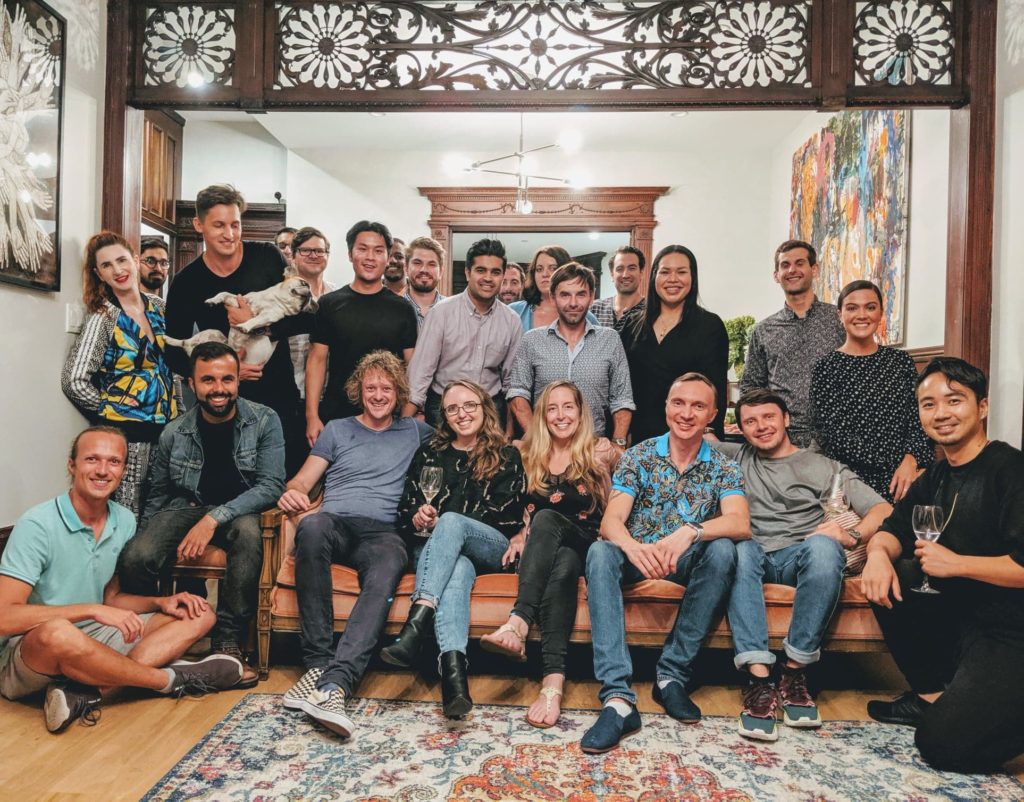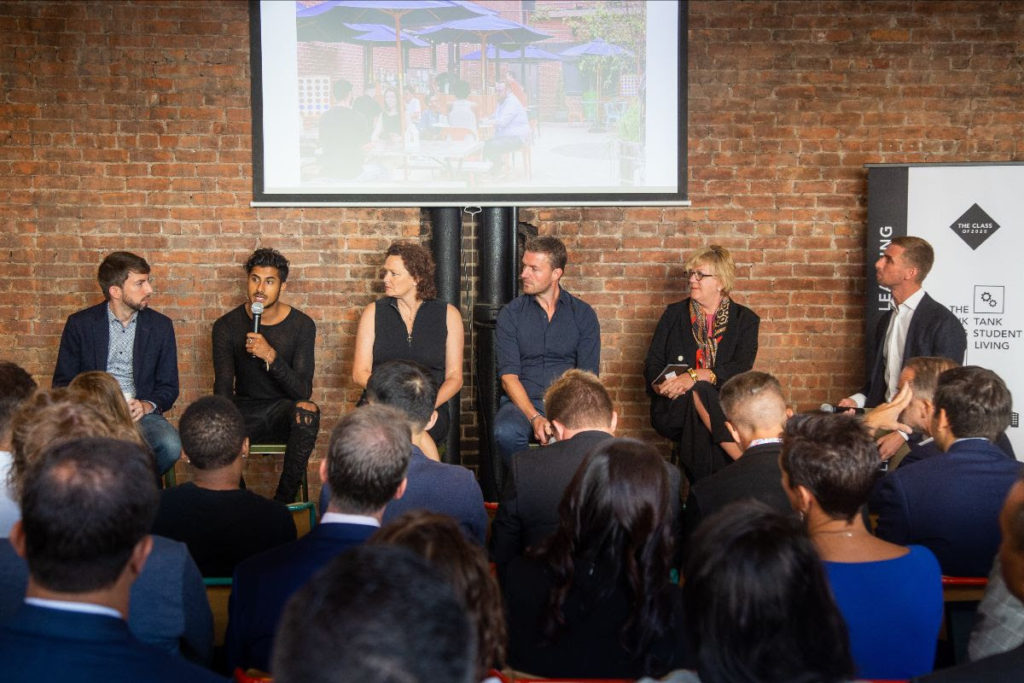One of Conscious Coliving’s co-founders and coliving consultants, Matt Lesniak, spent a month in New York in August/September visiting family and coliving industry colleagues throughout the Big Apple. Matt visited coliving spaces such as The Assemblage and Outpost Club, and attended The Class of 2020’s Future is Blended event at the WeWork in Soho.
This blog is a recap of that event, but before going into that it’s worth applauding The Assemblage’s biophilic design and wellness focus, as well as a Co-Liv meetup that was hosted at Outpost Club Park Place location with a majority of New York’s coliving operators present. Some of these operators included Ollie, Roomrs, Venn Bushwhick, Aleph Living, Stoop, Goal House as well as SALTO KS and Kndrd. And of course, Gui Perdrix (founder of Art to Co) joined the crowd See a fun pic below:

In terms of The Class of 2020’s ‘The Future is Blended: Trends in Coliving, Coworking and Student Accomodation’ event, this was the finale of a global tour of events exploring the blended future of live, work and play. There were some high quality moderators and panelists, including Reza Merchant from The Collective, Brad Hagreaves of Common, Charlie MacGregor from The Student Hotel and Stephanie Fuhrman of Greystar.
Some of the other experts and moderators included Jaclyn Sachs from the NYC Department of Housing Preservation & Development (who was involved in the Making Shared Housing Work publication), Mike Porrit from PBSA leaders The Scion Group, Ryan Murphy of Ollie and Susan Tjarksen of Cushman and Wakefield (who led their 2019 Coliving Report).The event was organized by Frank Uffen and Kristen Zupancic of The Class of 2020.
The Class of 2020 published a insightful recap after the event, which you can find here. We will elaborate on the insights given in the recap with some quotes from the event and some additional perspectives on the key learnings given in their blog. The key learnings of the event are the following:
1. The time for coliving is now: Susan Tjarksen of Cushman and Wakefield argues that coliving “is a vast growing market niche in real estate that has already started to garner institutional support.” We too have seen how the market and institutional support has rapidly grown, and provide our own industry standards with our Conscious Coliving Manifesto.
2. Affordability is key: at a time of high rental burdens throughout large metropolitan areas around the world (and even in secondary markets), we couldn’t agree more. But what constitutes affordability exactly? Is it just providing an all inclusive alternative to traditional studios for middle income populations? Or can it go even further to include a wide variety of socio-economic income classes? You can look into London based LivShare for some of these innovations. It’s also interesting to think about how using sustainable and streamlined construction methods can lead to cost savings and in turn more affordability for future residents.
3. Millennials are on the way out, Gen Z is on the way in: this is a big point that must not be missed. Susan Tjarsken had another relevant comment about this: “Gen Z is in the position to demand the kind of housing they want, and they won’t take what is given. This will make a great shift in the supply of what we provide”. As a human-centered product, coliving developers and operators need to take into the needs and lifestyles of Gen Zers. Here is an interesting perspective on what Gen Zers look in for homeownership, which admits Gen Zers are still looking for homeownership, but using renting as a stepping stone towards this. Sounds to me like an opportunity for fractal ownership in coliving…
4. New generations value experience over material possessions: Reza Merchant from The Collective says it this way: “At The Collective, we are not focused on any type of person or specific demographic, but on a certain mindset.” Reza says the rise of coliving is due to a “shift in value systems and a growing awareness of the need for human connection”. Millennials and Gen Zers also value deeper connections, belonging and community (see the ‘Evolution of a Renter’ graph from London-based Conductor below). It’s interesting to look into how coliving spaces can satisfy these demands and ultimately our fundamental human needs. Our consulting associate Gabriel Voto looks into this in his recent article about Max Neef’s fundamental human needs.
5. The future is blended: everyone from Greystar to JLL to Accor to Ascott are looking into blended multifamily/hospitality/coliving/coworking models. Greystar’s Stephanie Furhman is looking into how coliving “can combine purpose-built housing with flexibility and is aiming to offer all possibilities of the spectrum from hotels to purpose-built rental homes and serviced apartment in the same building or the same block.” We’re also very interested in how to combine the best innovations in human-centered design, placemaking and sustainability to create neighborhood hubs that maximise the social, economic and environmental value in their local communities. Check out our publication in the Conscious Cities Anthology 2019 that explores this topic here.
6. Institutional players are catching on: as Brad Hargreaves from Common asked during the conference, how can coliving “make an institutional product that appeals to the lending market while getting the same returns”? A recent European Living Report from JLL looks into investor appetite of coliving and other similar residential models. Nearly three quarters of the investors surveyed agreed that coliving is seen as the most likely sector to increase in investment volumes. Another motivating stat from the report shows that “80% of respondents believe that ESG (environmental, social governance) will be a key driver of future living investment decisions”. We absolutely agree and strongly encourage coliving developers and operators to integrate ESG metrics at the core of their business models.
7. Coliving concepts are recession resilient: the argument is that other “real estate sectors fluctuate in line with economic cycles, but demand for good quality homes and places to live will only increase in the long term” (Reza Merchant). There is also an interesting point about being recession resilient versus recession proof. The real estate sector is still vulnerable to economic recession, but by being a developer/owner/operator, coliving ventures provide a basic need that is demanded everywhere.
8. Safety first: the coliving sector has proved that it can create safe, high-quality spaces that incorporate IoT solutions to streamline building security and maintenance operations. We’ve also been building out partnerships with IoT access control solutions such as SALTO KS to ensure streamlined access control so coliving operators and developers can focus on what matters most: enhancing the community experience for their residents and neighbours.
9. It’s not rocket science, but it makes sense: the business case for coliving is starting to prove itself and the social value potentials of coliving are equally as present. Reza Merchant believes that the coliving sector will evolve into “a truly intergenerational offering that blends public and private space, bringing together human beings of all ages to live in a communal and connected way’. We are keeping a close eye on some of these models such as Common’s Kin, and very much looking forward to the future of modular and affordable urban living models such as Space10’s Urban Village Project.
10. It’s about attracting talent: Frank Uffen, co-founder of The Class of 2020 argues that metropolitan areas must focus on their territorial attractiveness and “attract and retain talent with the right housing propositions and by helping remove barriers to entry”. Planning authorities and city officials need to take some leaps in terms of innovative planning regulations, such as NYC’s ShareNYC program and the Mayor of London’s Policy H18 for large-scale purpose-built shared living regulation in the New London Plan. Alongside industry partners and leaders such as The Class of 2020 and Co-Liv, we also strive to help lobby for coliving to ensure cities are integrating sustainable placemaking practices and fostering thriving communities.

This was a very informative event with lots of quality content, moderators and panelists. One of my favorite insights / quotes from the event was from Brad Hargreaves about retention rates at Common:
“The biggest determinant of renewals in Common spaces is residents who are making a friend in the first two weeks. This leads to a 75% of renewal versus 55% in most traditional multifamily offers”
Brad Hargreaves, Common
This is a great insight on the importance of community facilitation and strong onboarding processes that integrate new residents into the community intentionally and supportively.
The Class of 2020 will also be hosting a larger The Future is Blended event for The Class Conference 2019 in Berlin this November. The event also has an awesome line-up and we are also planning on hosting a fun interactive experience during the event. Hope to see you there! In the meantime check out our newsletter for some more local events we are hosting in Berlin, London and Paris.
This article has been coauthored for you by:
Penny is Director of Research & Sustainability at Conscious Coliving. She has an MSc in Social Research Methods, and her PhD explores how shared living may enable lowered environmental impacts. She has consulted on numerous shared living projects, specialising in impact strategy, concept, and community. Penny has presented at conferences including the Co-Liv Summit, the Urban Living Festival, BTR360 and more. She has also authored publications in The Developer, Coliving Insights Magazine, the book Urban Communal Living in Britain, as well as being interviewed by the BBC and the Guardian about shared living.
Matt is responsible for designing community experience and impact strategies and measuring the social value of coliving communities. Matt is also a founding member and current Head of Community of Co-Liv and has worked for The Collective on their Impact Team.